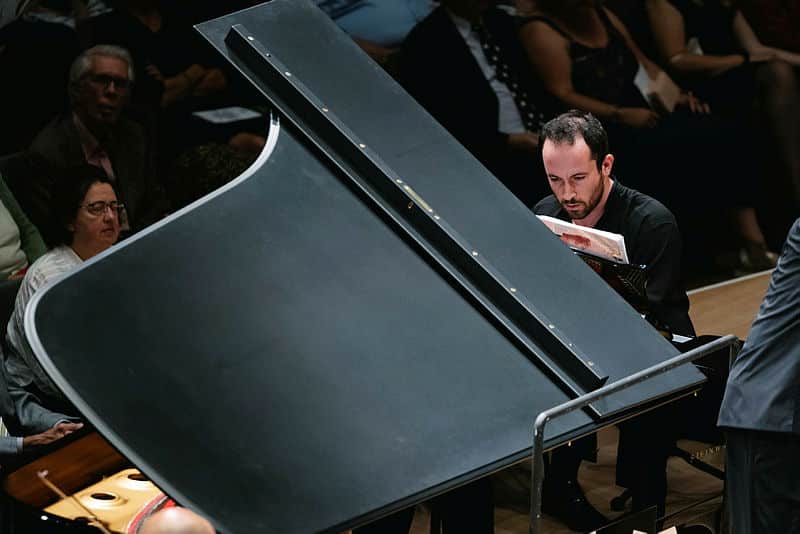Hamburg names Elbphilharmonie orchestra bosses
mainThe veteran Achim Dobschall, 60, will take over the management of all NDR orchestra, chorus and concert activities at the Elbphilharmonie. He replaces Andrea Zietzschmann, who is off to become intendant of the Berlin Philharmonic.
The NDR Elbphilharmonie Orchestra itself will be managed by Sonja Epping, presently at the Gewandhaus.






The NDR orchestra is one of the great orchestras of Germany. But their new hall is a grave mistake, as all of those quasi-utopian monstruosities are, supposed to be an appropriate environment to present classical music. In those star trek imitations, classical music suddenly makes an odd impression, as something not related to the present as represented by the hall which tries its best to look like a space ship, entirely separated from the earth’s past. But classical art is atemporal, like mathematics, as the well-known architect Leon Krier says, and especially classical music as an art form relates to the innate perception framework of the human mind and heart and ears, as developed over ages of evolution, biologically rooted, and thus always contemporary because o based upon universals. Such halls as the Elbtraum reduce most of the music that is played there, to the glass box of a museum culture, which is exactly the OPPOSITE of what the building is intended to do. It is a chique museum glass box, cutting-off the music from the holistic nature of human perception (Steven Semes).
http://www.futuresymphony.org/le-violon-dingres-some-reflections-on-music-painting-and-architecture/
But for sonic art, the Elbtraum is perfect, of course. One cannot imagine that an orchestra like the NDR would want to restrict their repertoire to Klangkunst. It would also be a catastrophic financial idea, the audience for Klangkunst being very small.
Dear God, when will you sod off and give us all a break?
He is right!
I am always interested to read what John has to say and in small part I agree with him. However, having seen the building and its locale I must say I find it impressive. It doesn’t take a flash new building to reduce art music to “the glass box of a museum culture”. I must say I prefer the ‘museum’ to anything created within the last 30 years or so, with a couple of rare exceptions. Didn’t take a particular building for me to develop my antipathy.
It’s a building made to impress visually. Not acoustically. It’s an anti-musical building. It’s impressive visuals are not disputed by anyone. It’s just absurd as a concert hall for experiencing classical music performances. It could have great uses for circus performances. or boxing. table tennis. you name it.
Yes, he is. JB says perceptive things about form and function in architecture in the context of art music.
Phillip Kennicott in the Washington Post on the 15th wrote, “The acoustics, designed by the renowned Japanese acoustician Yasuhisa Toyota, are a marvel of clarity, precision and cool objectivity.” There are other judgments about the acoustic qualities, I gather.
Of course!
I tried playing both the Hammerklavier and my Fantasia contrappuntistica in it, the acoustic sucks, I cancelled my concert and went to Wigmore hall, miles better.
Wow you seem to have read alot about the Elphi Mr. Borstlap. Ever hear a concert there? When you have experienced the hall woth your own ears, by all means, regale us with your critique.
I have performed there several times this season and I find the acoustics to be fantastic.
It seems to be dependent upon which music is played and in which formation. Circular concert halls, or halls in which the audience also sits left and right and/or behind an orchestra, are not much suited for orchestral concerts, since the seating plan of a symphony orchestra is acoustically designed in layers according to volume, sound mass and projecting strength: brass and percussion at the back, then the woodwind, and the strings fanning-out in front, so that the sound of brass and woodwinds, with the occasional supporting percussion, can blend into the string sound before being projected into a shoebox-sized hall where the sounds can be experienced in balance and clear relationships. The same problem can be seen with the piano: lid open to the audience – but what if there is also audience at the back? When the lid is taken-off, some of the projection is lost. The same with singers and partly also with strings. There are good reasons why the shoe box design works best for concert halls.
Acoustics from the position of the performer and acoustics from the position of the audience – all the different seats and their average for a given particular instrumentation and seating – are very different animals.
A concert hall for instance hat feels great on stage, but does not project that sound to a majority of seats out there, is rather pointless. Toyota is famous for such designs.
Musicians on stage often like them. But long faces in the audience, where nothing is good.
Also there are many first hand accounts from musicians who have performed there, who think the hall sucks big time. Too dry, too weak, no blend, harsh.
Toyota says publicly in interviews, he wants a modern concert hall to sound like a modern recording. Very direct and clear. That man is insane. He has no idea about blend and strength.
And of course the Schildbürger-build-concert-hall nonsense with the too many seats on the sides and in the back of the orchestra, where directional instruments and singers project away from.
But can a serious open discussion about the hall be had? After the enormous amount of public money that was sunk into it? Probably not. It must be protected against critical assessments. It’s what you get when people build concert halls driven by primarily vanity.
Would that be anything like Sydney Opera House, the pit of which (in the opera theatre) is too small for the performance of Wagnerian operas and which has loads of ‘partially restricted viewing’?
I thought that the architect of the Sidney opera house was of the opinion that as many as possible audience members should not see what was happening on stage.
That’s a different problem. The problem with Hamburg is, that the hall is built with good (visual) view for everybody to the stage as the primary objective. Acoustics suffer.
Many concert listeners can now enjoy the backside of the musicians, singers, performers on stage, their hairdo (or loss of hair) but do not hear much of them, since they project forward. The hall also lacks blend. And it lacks acoustical strength. This layout is predestined to such shortcomings, it’s almost impossible to avoid.
Also if Lady Evercough opens her handbag across the hall on the other side of the spectators galleries, and takes out a cough drop, now the acoustics are great for everybody to hear the unwrapping clearly. It’s socially very engaging…
It’s a hall built for visual spectacles. It’s what architects do if you let them, and nobody is there to be advocate for the music. The people who say for it and decide about the money primarily want a hall where they see themselves visually present as well. To be seen there… Music comes second in these architectures. The fatal trend started with Berlin Philharmonie, which is not a good acoustic for classical music. But it has a great resident orchestra which now knows how to play the hall and how to create strength and warmth in it *against* its designed lack of it. Nobody can argue that Berlin Philharmonie looks great. But acoustics are better in many other halls, often shoeboxes, some hybrid designs als but with lesser amount of people behind the stage.
Nobody can make a singer or a cello player project sidewards or even backwards.
These halls should die out, they were a dead end street, a fashion at a time. Today we know better. Or we could know better, me must sadly state.
It needs a lot of insider knowledge, to know all the details and stories around it, and how usually the facts are silenced after all the money has been spent. The larger public has no idea how to tell a good acoustic from a not so good acoustic.
It was worth a try in the 1960s. But building it today still, is quite idiotic, or vane. (vanity being just another form of idiocy, with an aesthetic touch though 😉 )
A wise comment.
Also it is quite funny how some concert halls look like some unfortunate space ship that crashed onto earth (Disney Hall in LA, Phiharmonie de Paris).
To my feeling, many concert halls are simply too big, obviously built with monster scores with chorusses in mind, like Mahler VIII. A relatively small shoebox hall does most of the classical repertoire the best service, to my experience. Ideal: Musikverein in Vienna. The Concertgebouw in Amsterdam lays a beautiful veneer over the sound, but it is not very clear, even that hall seems to me too big. The concert hall in Rotterdam, a modernist luxury creation from the sixties, is so big that if you sit somewhere in the back area, the sound is remote and blurred.